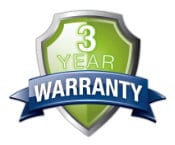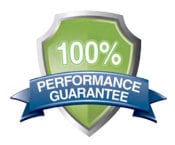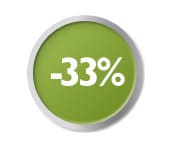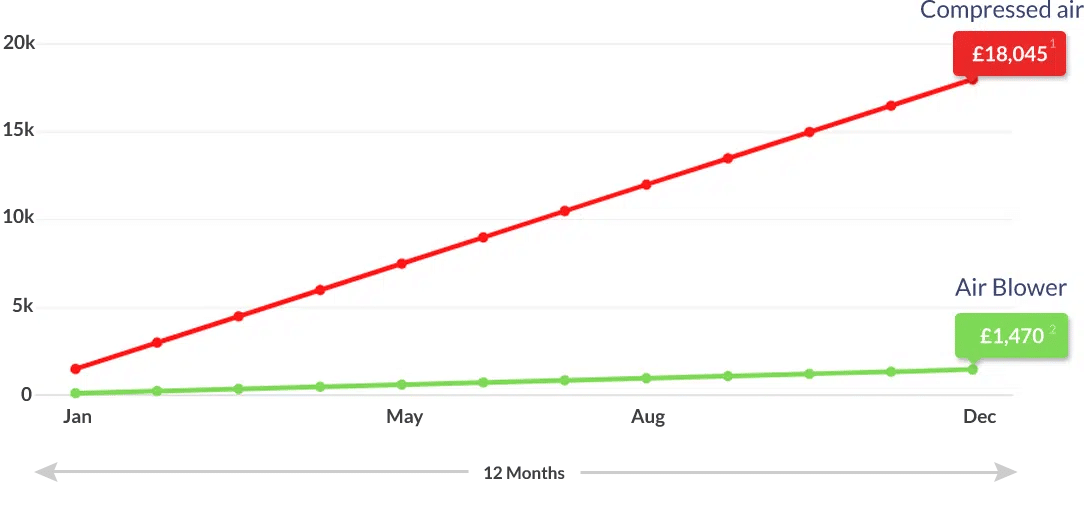
The issue that both compressed air and blower systems need to address is how to generate a high flow of air at a good impact velocity.
Compressed air systems release air to atmospheric pressure and so need to generate pressures up to 6 Bar. As well as this, compressed air is often the most expensive energy source for manufacturers. Compressed air systems often have high system inefficiencies, with as little as 10% of the energy used by compressed air systems being converted into usable energy.
In contrast, blower systems only need to generate pressures up to 0.25 Bar (although most applications only need a pressure of around 0.15 Bar (150mBar)) to achieve the same velocity as the 6 Bar compressed air system.
And this is the significant difference between the industry-standard solutions of compressed air versus specifically designed blower systems.

| Specification | Small | Medium | Large |
|---|---|---|---|
| A:Inlet Capacity m³/min | 6.31 | 11.6 | 42.3 |
| B: Converted to m³/hour (A x 60) | 378.6 | 696 | 2538 |
| C: Compressor Power kW | 42.6 | 79.3 | 271.9 |
| Power (C) ÷ Air Capacity (B) = kW per m³/hour | 0.1125 | 0.1139 | 0.1071 |
| Industrial Application | Compressed Air | Blower System |
|---|---|---|
| Intermittent Air Flow | Compressed air can be the best solution if airflow is required intermittently, and your process only needs a 5-second blow-off every minute. | Whilst blowers opperate continually intermittent air flow is possible with the use of a solenoid air valves. |
| Continuous Air Flow | Not suitable for applications which require an airflow of more than 5 seconds every minute. | Concentrated air flow, able to run continuously 24/7 at low cost and with energy efficiency. |
| Blow-off | Ineffective at blow-off for most industries. Compressed air is only effective at targeted close range blow-off. | Low pressure, high-velocity air flow suitable for a wide range of blow-off applications. |
| Contamination | The cooling process needed to maintain compressed air means some fluid (oil and/or water) is ejected in the airstream, affecting drying applications. | Generates clean air - no air or oil needed in the system, meaning expelled air is dry. Able to create “air curtain” protective barriers. |
| Moisture Regulation | High cost to run continuously, difficult to ensure precision needed for moisture regulation. | Air flow able to be easily directed, to create an “air curtain” laminar air flow that adheres to surfaces, meaning it can remove or regulate moisture on a surface as needed. |
| Large Products | Small air outlet slots mean the size and energy requirements needed to deliver air over longer lengths are disproportionately large. | Air Knives available in 10mm increments up to 3.5metres. Capacity for large scale Air Knives easily supports large product drying/blow-off/moisture and contamination control. |
Compressed air is most commonly used in applications that either require intermittent bursts of air or air that has been compacted.
This includes pneumatic drills, power tools, air cylinders for automation, air brakes and sandblasting.
Air Blowers are used in applications where air is required to be continuous, or when a high-velocity air stream is needed.
This includes water management, removal or regulation on objects, creating sterile environments for research, pre- and post- production applications, including painting or processing in ovens/furnaces.

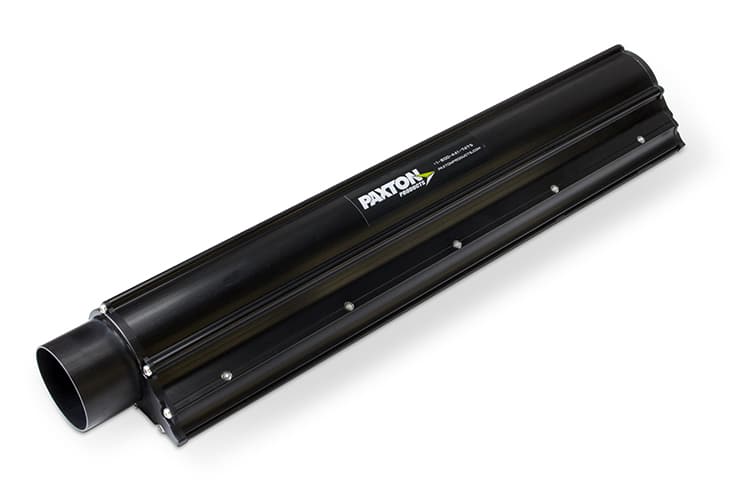
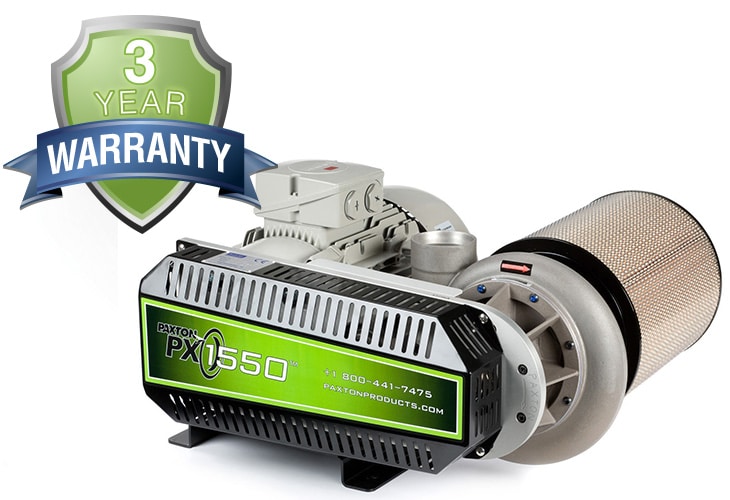
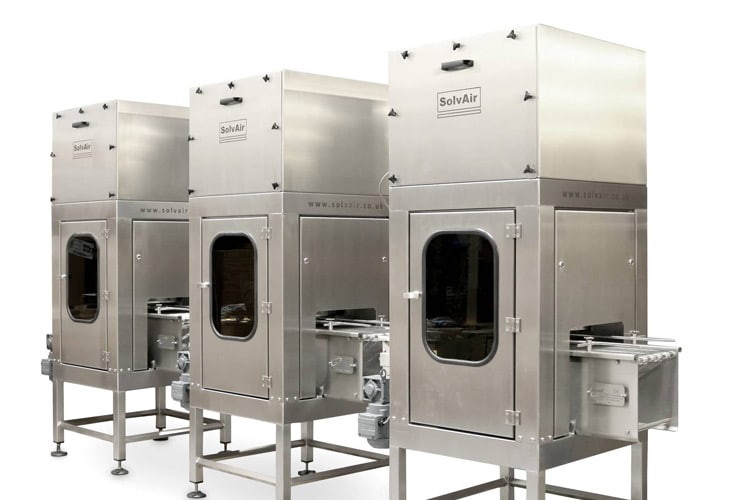
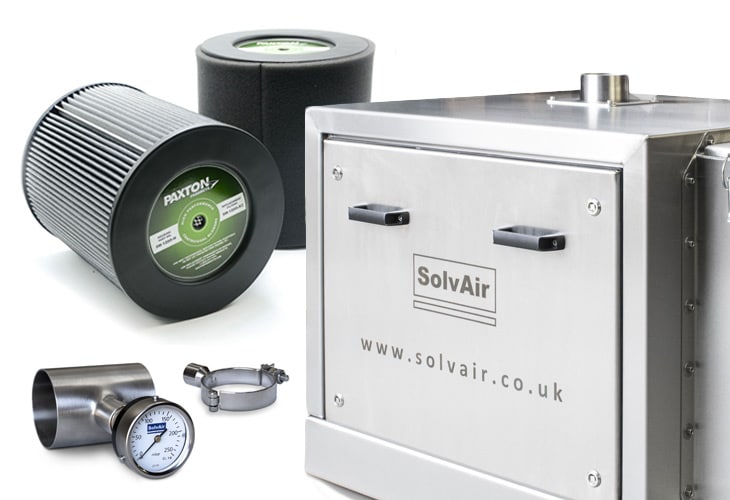
Often compressed air is used by factories for cleaning/drying/blow-off applications because the compressed air supply already exists, and so it can quickly be repurposed for this purpose at a minimal additional cost.
Yes – blower systems generally outperform compressed air systems as they work at much higher flow rates.
Our blower range includes models starting at 2.2KW through to 15kW. Across this range we average a typical output of 180mm width per kW power consumed.
An easy method for checking your compressed air consumption is to assess the volume of air used in cubic metres. You can then use the calculation 1m³ = 0.11 kW.
Factories often use heated air systems to dry products. Heated air systems rely on evaporation to dry products and are often used on relatively slow speed production lines.
Compressed air can be the best solution for factories. For example, if airflow is required intermittently, and your process only needs a 5-second blow-off every minute, compressed air can be used with a solenoid valve to start/stop the supply.
